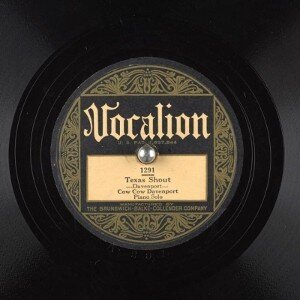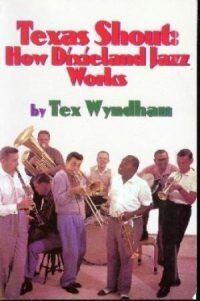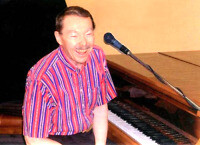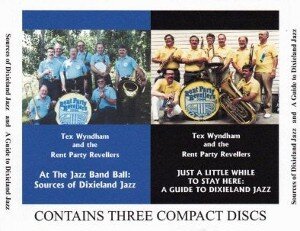 Set forth below is the thirty-ninth “Texas Shout” column. The initial installment of a two-part essay, it first appeared in the May 1993 issue of the West Coast Rag, now known as The Syncopated Times.
Set forth below is the thirty-ninth “Texas Shout” column. The initial installment of a two-part essay, it first appeared in the May 1993 issue of the West Coast Rag, now known as The Syncopated Times.
Two terms you’ll encounter as you read your older-style jazz festival programs are “western swing” and “Spanish tinge.” What types of music do these describe and how do they fit into the older-style jazz picture?
By “older-style” jazz, I mean the types of jazz played at festivals covered by WCR, i.e., Dixieland and swing (which I will refer to collectively in today’s column as “D/S”). “Dixieland” is the generic term covering several styles of jazz utilizing the jazz vocabulary and conventions of the twenties, while “swing” is the generic term describing jazz styles utilizing the jazz vocabulary and conventions of the thirties. For reasons set forth below, I need to distinguish D/S, for today’s purposes, from bop and other more advanced jazz forms.
A band is playing western swing when it plays jazz licks, which may or may not be improvised, over a country/western rhythm, i.e., a rhythm section using the types of shuffle and back-beat characteristic of country bands rather than jazz bands. A band is using Spanish tinge when it plays jazz licks, which may or may not be improvised, over a rhumba, tango, samba or other Latin beat.
Thus, although these two musics contain non-jazz features, they both utilize devices to which jazz fans can relate. It would seem logical, then, that there should be a place for each at broadly-based jazz festivals.
In fact, as we all know, Igor’s Jazz Cowboys, a highly-polished show band playing both western swing and straight western music, is one of the most visible and popular acts on the D/S festival circuit. Similarly, Guatemala’s Paco Gatsby, a band that, in large part, plays D/S figures above Latin rhythms, has been a successful attraction for D/S festivals that can afford to import the combo.
The popularity of these bands has caused controversy in these pages and elsewhere. Why?
Well, if you’ve been a faithful reader of this column, you’ll be familiar with my view that the thing that distinguishes D/S from other similar types of music is its approach to rhythm, i.e., the notes of D/S are articulated in a manner generating a particular kind of passionate forward movement described by the jazz community as “hot and swinging.” Unless the music is played with that type of rhythm, it isn’t D/S.
As explained above, western swing and Spanish tinge are not played to this special type of jazz rhythm. Thus, for our purposes, though they may have jazzy characteristics, neither is jazz.
Since the bossa nova craze of the sixties, modern jazzmen have made many records with Latin rhythm which are promoted as jazz and apparently are accepted as such by modern jazz fans. Of course, modern jazz deliberately set out to break some of the commonly-accepted rules of older-style jazz.
Although I have trouble with the concept of jazz being played in anything other than jazz time, I do not claim to understand the rules of the various styles of modern jazz, a type of music that doesn’t do much for me. For that reason, I’m limiting my discussion of jazz in today’s column to D/S.
Look at the subject this way: If you start playing a jazz solo in the middle of a country band, you’re producing jazzy country music, not countryish jazz. If you want countryish jazz, then you should play fiddle or bluegrass licks to a jazz beat as, for example, the Dixieland Jug Blowers did in the twenties.
Similarly, if a trumpet, clarinet and trombone improvise “Ja-Da” to a rhumba beat, they’re producing jazzy Latin music, not Latinish jazz. If you want Latinish jazz, then play bullfight-type trumpet figures, or melodies with a Latin sensibility, to a jazz beat as, for example, in “Cielito Lindo” from the LP “Orange Kellin In New Orleans,” Center CLP-7.
The most familiar example of Latinish jazz is undoubtedly the Dixieland flagwaver “Panama”, composed by Wm. H. Tyers (who was from the West Indies), originally published in 1911 as a slow four-strain piece, with introduction and tag, entirely in Latin rhythm. However, generations of jazz bands closing sets with this one have probably made it difficult for most of us to visualize “Panama” as consisting of Latin themes played to jazz time.
My conclusion that western swing isn’t jazz is generally supported by record producers and sellers, who usually group western swing bands with the country/ western elements of their catalogs rather than with the jazz elements. Moreover, western swing is typically not included in jazz discographies.
Similar statements can’t be made for Spanish tinge because, except for Paco Gatsby, I am not aware of any D/S-oriented combos that have made Spanish tinge the major portion of their repertoires. The questions of how to promote records by such combos, or where to put them in discographies, really haven’t come up as yet. However, I feel confident that, if they ever do come up, they will be dealt with in the same way as western swing.
I doubt that many readers will be upset by my conclusion that western swing isn’t jazz. Quite a few Dixielanders don’t care all that much for western swing anyway.
However, more may be disturbed by that conclusion regarding Spanish tinge. After all, since the earliest days, Dixieland musicians have occasionally played tunes to a Latin beat. Jelly Roll’s lovely “New Orleans Joys” and “The Crave” are regularly heard at Dixieland festivals. And what jazzman hasn’t played Handy’s immortal “St. Louis Blues,” with its haunting Latin-rhythmed second strain?
In that respect, let me state emphatically my belief that such music does belong in the repertoire, and that there is nothing wrong with using it to spice up, and add variety to, the program. Any music which draws heavily from D/S can successfully be presented to D/S fans, thereby enhancing everyone’s good time and broadening the audience’s appreciation of the artists who contributed to D/S. Doing so is analogous to playing Scott Joplin’s waltzes, marches and other non-rag compositions at ragtime festivals, where such selections are welcomed by ragtime aficionados.
However, I also believe that, if we consider D/S to be an art form, then we ought to understand what kinds of music belong to it and what kinds don’t. Moreover, if one has that understanding, then one is better able to appreciate the nature of the current controversy over the “legitimacy” of certain bands on festival programs.

The full run of “Texas Shout” has been collected into a lavishly illustrated trade paperback entitled Texas Shout: How Dixieland Jazz Works. This book is available @ $20.00 plus $2.95 shipping from Tex Wyndham, On request, Tex will autograph the book and add a personalized note (be sure to tell him to whom the note should be addressed).
Tex Wyndham’s 3 CD Guide to Dixieland with music and commentary is available for $20 plus $2.95 shipping. The separate CD, A History of Ragtime: Tex Wyndham Live At Santa Rosa, is available for $13.00 plus $2.00 shipping. On request, Tex will autograph the inner sleeve and add a personalized note (be sure to tell him to whom the note should be addressed).
Send payment to Tex Wyndham, P.O. Box 831, Mendenhall, PA 19357, Phone (610) 388-6330.
Note: All links, pictures, videos or graphics accompanying the Shouts were added at the discretion of the Syncopated Times editorial staff. They did not accompany the original columns and do not necessarily reflect the opinion of Tex Wyndham.
From roughly 1970-2010, Tex Wyndham was: (1) one of the best-known revivalist Dixieland jazz musicians in the US, as cornetist, pianist and bandleader, (2) one of the best-known ragtime pianists in the US, and (3) one of the most respected critics in the US of Dixieland jazz, ragtime, and related music. He is the only person about whom all three of those statements can be made.




